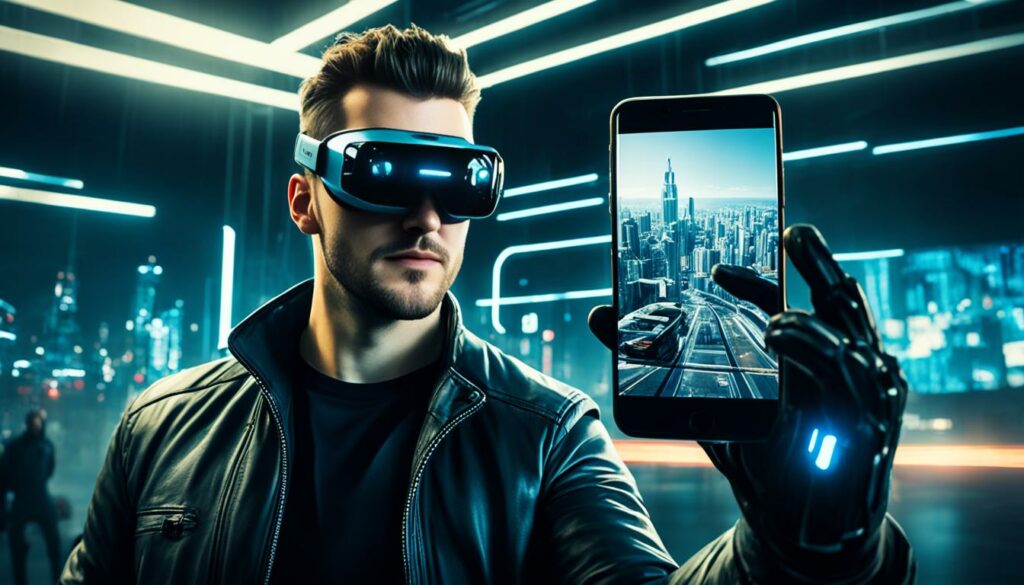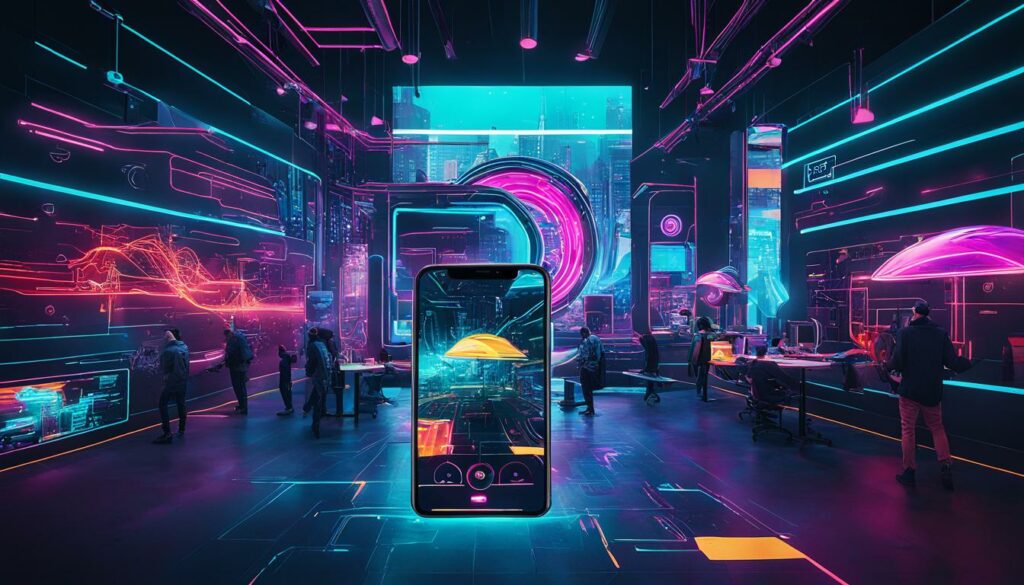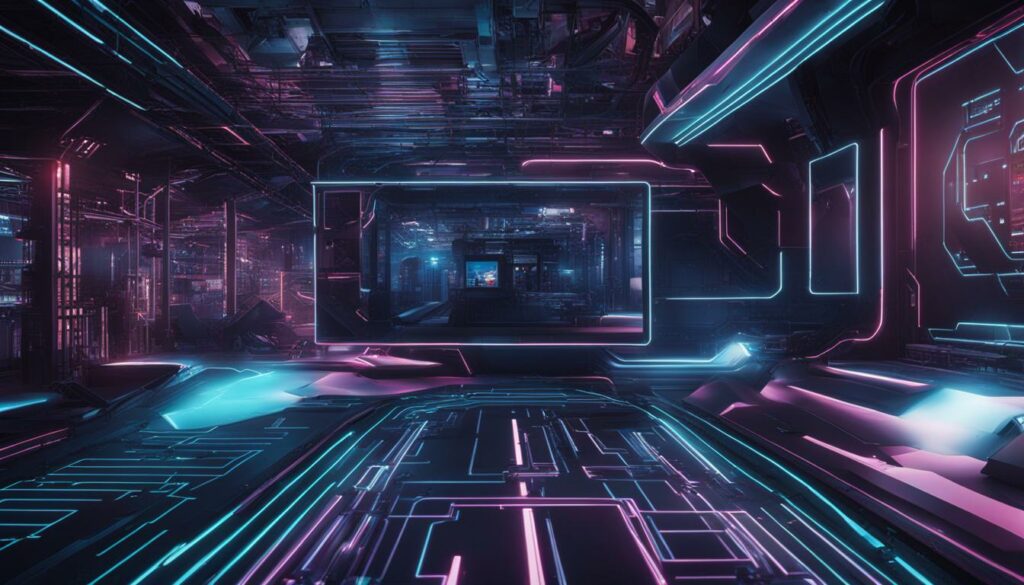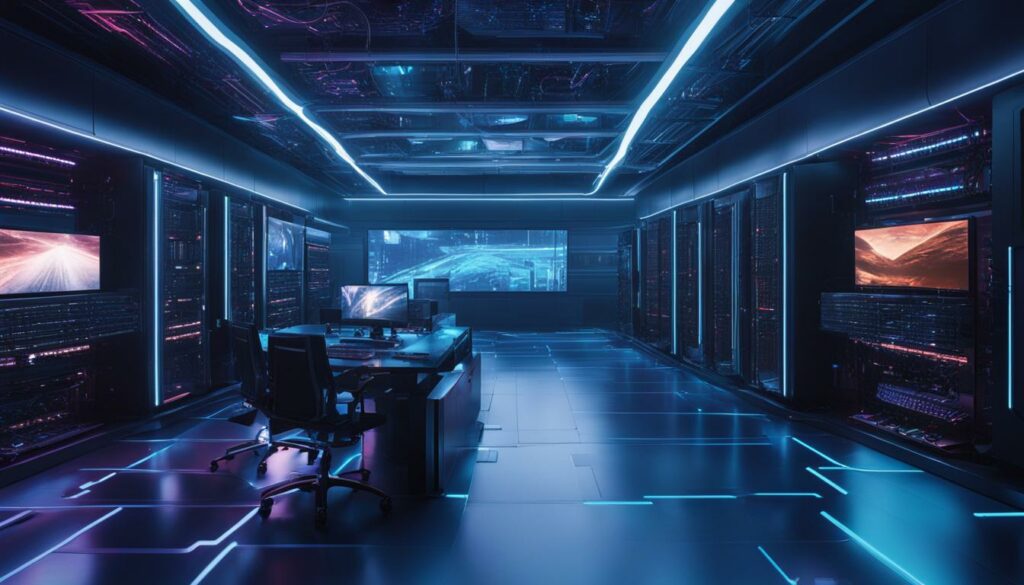Augmented Reality (AR) is an exciting technology that adds computer-generated elements to the real world, creating immersive experiences for users. Whether you’re designing AR marketing campaigns, educational tools, or entertainment experiences, choosing the right hosting provider is essential for optimal performance and reliability. In this article, we’ll delve into key insights and best practices for hosting augmented reality, helping you enhance your AR experiences and captivate your audience.
Key Takeaways:
- Choosing the best hosting provider is crucial for seamless AR experiences.
- Consider factors such as affordability, reliability, and performance when selecting an AR hosting solution.
- Understanding the benefits of AR can help you leverage its power for marketing, education, and entertainment purposes.
- Different types of AR platforms exist, including mobile devices, headsets, glasses, and projectors. Choose a platform that suits your specific needs.
- Designing engaging and interactive AR content involves using animations, gestures, audio, and visuals to captivate users.
Now, let’s dive deeper into each section and explore how you can make the most of hosting for augmented reality.
Understanding Augmented Reality and its Benefits
Augmented reality (AR) is a technology that overlays digital content on the real world, creating interactive and immersive experiences for users. By enhancing our perception of reality, AR has become increasingly popular in various industries, including marketing, education, and entertainment.
Incorporating AR into your marketing strategy can provide numerous benefits. Let’s explore some of the key advantages of using augmented reality:
- Increased User Engagement: AR captivates users by offering unique and interactive experiences, driving higher levels of engagement and brand interaction.
- Improved Brand Awareness: AR campaigns can generate buzz and excitement, helping to increase brand visibility and recognition.
- Competitive Advantage: By adopting AR, businesses can stay ahead of the competition, demonstrating their innovation and technological prowess.
To create compelling AR experiences, you’ll need access to an AR design toolkit. This toolkit includes a variety of tools specifically designed for developing and designing AR content.
With an AR design toolkit, you can:
- Develop custom AR applications to meet your unique business needs
- Create stunning visual effects and interactive elements
- Integrate AR functionality seamlessly into your existing apps or websites
By leveraging these tools, you can unlock the full potential of AR and deliver unforgettable experiences to your audience.
Comparison of Popular AR Design Toolkits
| AR Design Toolkit | Features | Platforms |
|---|---|---|
| Unity | Powerful 3D rendering capabilities Extensive library of assets Easy integration with AR frameworks |
Windows Mac Linux iOS Android |
| Vuforia | Image recognition and tracking Multi-platform support Cloud-based services |
iOS Android Unity |
| ARKit | Advanced motion tracking Environmental understanding Face tracking |
iOS |
Choose the AR design toolkit that aligns with your specific requirements and technical expertise. Whether you’re creating AR marketing campaigns or educational experiences, a robust and feature-rich toolkit will enable you to bring your vision to life.
Types of AR Platforms for Hosting
When it comes to hosting AR content, there are various platforms available to choose from. Each platform offers its own unique features and limitations. Let’s explore the different types of AR platforms that you can consider for hosting your content.
1. Mobile AR

2. AR Headsets
AR headsets, such as the Microsoft HoloLens and Magic Leap One, provide a more immersive AR experience compared to mobile devices. These headsets overlay digital content directly onto the user’s field of view, creating a realistic and interactive experience. AR headsets often have a wider field of view and more advanced tracking capabilities, allowing for a more seamless integration of virtual and real-world elements. However, AR headsets can be bulky and expensive, making them less accessible to the general public.
3. AR Glasses
AR glasses, also known as smart glasses, are wearable devices that display digital information in the user’s line of sight. These glasses provide a hands-free AR experience, allowing users to interact with digital content while still being aware of their surroundings. Some popular AR glasses include the Google Glass and the Vuzix Blade. AR glasses offer the advantage of convenience and mobility, but they may have limitations in terms of display quality and battery life.
4. AR Projectors
AR projectors, as the name suggests, project AR content onto physical objects or surfaces. These projectors use advanced tracking technology to align the digital content with the real-world environment. AR projectors can transform any surface into an interactive display, enabling users to engage with AR experiences in a unique and immersive way. However, AR projectors may require a controlled environment with optimal lighting conditions to ensure accurate projection.
Each AR platform has its own strengths and limitations. When choosing the right hosting platform for your AR content, consider factors such as your specific needs, the requirements of your AR experiences, and the target audience. Ultimately, the platform you choose should provide a seamless and immersive AR experience for your users.
Designing Engaging AR Content
When it comes to AR, the key to success lies in designing content that captivates your users and keeps them engaged. To create truly immersive experiences, incorporating interactive elements such as animations, gestures, audio, and visuals is essential. By leveraging these features, you can enhance user interaction with your AR content and provide a memorable and impactful experience.
One of the most effective ways to engage users is through AR animations. Animations add life and movement to your content, making it more dynamic and visually appealing. Whether it’s a playful character or a stunning visual effect, AR animations can bring your content to life and capture the attention of your audience.
AR gestures play a crucial role in user interaction. By incorporating intuitive gestures, such as tapping, swiping, or pinching, you can enable users to interact with your AR content seamlessly. These gestures enhance the sense of control and enable users to explore your content in a more interactive and natural way.
Another important aspect is the use of AR audio. Sound effects, narration, or music can greatly enhance the user experience by providing auditory feedback and immersing users further into your content. The right audio can create a sense of atmosphere and emotion, making the AR experience more engaging and memorable.
Of course, visuals are a crucial component of AR content design. Creating visually appealing content that aligns with your brand and message is essential for conveying information effectively. Striking visuals can grab the attention of users and make your AR content more memorable and impactful.
When designing AR content, it’s important to strike a balance between providing relevant and meaningful information without overwhelming the user. Avoid clutter by prioritizing essential features and functions, ensuring that your audience can easily navigate and interact with your content.
Remember, the goal is to create an immersive and interactive experience that captivates your users. By thoughtfully incorporating animations, gestures, audio, and visuals into your AR content design, you can deliver an engaging and memorable experience that leaves a lasting impression.

Optimizing Performance for AR Hosting
The performance of your AR content is crucial to providing a seamless user experience. To ensure your content performs at its best, it’s essential to optimize it for speed, quality, stability, and load time.
Consider the following factors when optimizing your AR content:
- Bandwidth: Ensure that your hosting platform provides sufficient bandwidth to handle the data transfer required for your AR content.
- Memory: AR experiences can be resource-intensive, so make sure your hosting provider offers ample memory resources to support your content.
- Processing Power: Choose a hosting solution that can handle the processing demands of your AR content, particularly if it involves complex animations or graphics.
Furthermore, implement the following techniques to improve the performance of your AR content:
- Compression: Compress your AR content files to reduce their size without compromising quality. This helps improve load times and overall performance.
- Caching: Utilize caching techniques to store and serve frequently accessed AR content more efficiently, reducing the load on your hosting infrastructure.
- Streaming: Consider implementing streaming techniques for large AR files, allowing users to access and experience content while it continues to load in the background.
Monitoring and measuring the performance of your AR content is essential to identify areas for improvement. Utilize analytics tools to track metrics such as load times, stability, and user engagement. Additionally, gather user feedback to gain valuable insights into their experience with your AR content.
By optimizing the performance of your AR hosting, you can ensure that your content delivers a seamless and immersive user experience.

Conclusion
Hosting is a critical factor in ensuring optimal performance and reliability for augmented reality (AR) experiences. By understanding the benefits of AR, choosing the right hosting platform, designing engaging content, and optimizing performance, you can create impactful and immersive AR experiences that captivate your audience.
When it comes to hosting AR content, it is important to consider the unique requirements and challenges that arise. Make informed decisions based on your specific needs to enhance your AR marketing strategy. By partnering with the right hosting provider, you can unlock the full potential of AR and take your experiences to the next level.
As you explore the world of AR hosting, remember to prioritize performance and reliability. Investing in the right infrastructure, managing content load times, and ensuring stability are key factors in delivering a seamless user experience. Regularly monitor and optimize your AR content using analytics tools and user feedback to stay ahead of the curve and provide the best possible AR experiences.
In conclusion, hosting for augmented reality is not just about finding a server; it’s about creating a seamless and immersive experience for your users. By incorporating the right hosting practices and continuously refining your AR content, you can leverage the full potential of AR to engage your audience and leave a lasting impact.
FAQ
Q: What is augmented reality (AR)?
A: Augmented reality is a technology that overlays computer-generated images on a user’s view of the real world, creating immersive experiences.
Q: How can augmented reality be used in marketing?
A: Augmented reality can be used in marketing to increase user engagement, improve brand awareness, and provide a competitive advantage.
Q: What tools are needed to develop AR content?
A: To create AR experiences, you’ll need an AR design toolkit, which includes tools for developing and designing AR content.
Q: What are the different types of AR platforms for hosting?
A: The different types of AR platforms for hosting include mobile devices, AR headsets, AR glasses, and AR projectors.
Q: How can AR content be made engaging and interactive?
A: AR content can be made engaging and interactive by using animations, gestures, audio, and visuals that enhance the user’s interaction.
Q: How can performance be optimized for AR content?
A: Performance can be optimized for AR content by considering factors such as bandwidth, memory, and processing power, and using compression, caching, and streaming techniques.
Q: Why is hosting important for augmented reality?
A: Hosting is important for augmented reality to ensure optimal performance and reliability for AR experiences.












